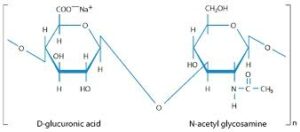Hyaluronic acid structure would be represented with detailed explanation about the formation. This compound comes in the category of compounds named Glycosaminoglycan (GAG). This article would describe the facts of the compound.
Hyaluronic acid (HA) is an organic compound, which is non-sulphated and called Hyaluronan. The structure of the compound is being described below for better knowledge about the compound.
Hyaluronic Acid Structure
The structure of Hyaluronic acid is quite complicated as it occurs as a polymer naturally. This is a polysaccharide. Non-protein Glycosaminoglycan are found as long entangled chain of sugar or carbohydrate. This is why the compound is called a polysaccharide. As it is a polysaccharide, the structure of this compound is quite complicated.
The structure of this compound is composed of D-glucuronic acid and N-acetyl-d-glucosamine joined by β-1, 3 and β-1, 4 glycosidic bonds in an Alternative arrangement of the groups. The repetition of disaccharides is the factor, which is followed by the compound in case of forming a stable structure. Carboxyl and hydroxyl groups are present in the structure of the compound.
This polymer has great application the formation of drugs, which are used ion medical industry. The unique capability of this compound makes it valuable physiochemical compound as per the usage.
The combination of two groups in the compound is joined with one oxygen molecule. The polymer possesses chain like structure, which is repeatedly holds the disaccharide groups, which makes it more, complicated in structure.
The compound is synthesised in tissues through biological process. It is important to identify the structural formula of the compound, which is being clearly shown in the above picture. This is a chemically modified structure. The repeating of the disaccharides can be degraded in presence of an enzyme named, hyaluronidases.
Acetamido, carboxyl and hydroxyl groups are present in this compound, which binds the compound and provides stability. There is no stability issue in the structure of the compound as it is a strong polymers which is considers to be valuable a-enough in polymer chemistry.
The degradation of this structure can be resisted by the esterification of the compound in presence of water. The water solubility of the compound is lowered by the process of degradation through “Esterification of Hyaluronic acid (HA)”. The chemically exceptional and modified structure of the compound provides several biological impact of the compound.
Microbial production of the compound is found to be very active in chemistry, however, the clinical value of the acid is notable and highly effective to produce drugs in pharmaceutical chemistry. This is distinguishable from the physiological expression.

The polymer chain is formed by the reaction between disaccharides which makes is biodegradable and less harmful for the human body. The complicated structure of the compound crates distinct overview of the compound through explanation of the existence of the compound in different level.
Modification of the structure of HA
The acid has a different tendency to modify as Hydrogels. Several processes are noticed to be followed by the compound to possess the modification. By depending on the expected application hydrogels are formed from the acid as sponges, fibres or microspheres.
Some effective methods are responsible for generating the hydrogels from Hyaluronic acid. Aldehyde cross-linking is the process by which the Hydrogels get fluency in formation. Except this method, the process of carbodimide cross-linking regulates the modification of the compound and Photocross-linking is also effective methods.
The acidic behaviour of the Hyaluronic acid is controlled through biological aspects. The compound binds the “specific cell surface receptors.” The synthesis of this acid is a continuous process. The continuous secretion from different part or cell of the animal body has been found biologically.
There is heterogeneous characteristics are found in the compound. The size of the structure is quite different and holds exceptional value in chemistry. Hyaluronic Acid is a naturally isolated compound. It creates a distinguishable hallmarked characteristic.
This signally molecule is discovered to be pharmalogically very active which means the compound has several use in pharmaceutical chemistry. High range of masses is present in the compound, which is more than normal polymer structure.
Frequently Asked Questions (FAQs)
Question 1: What kinds of bond are found in the Hyaluronic Acid?
Answer: The monomers (N-acetyl-d-glucosamine and D-glucuronic acid) are bound with the help of the β-1, 3 and β-1, 4 glycosidic bonds. However, the bonding structure of the compound is quite attractive and unique in the clinical chemistry.
Question 2: How HA is isolated from the natural sources. Name some of the sources.
Answer: The compound is found to be isolated from the natural terrestrial sources due to its long polysaccharide chains. As the compound is biologically modified and
Terrestrial sources like bacterial sources like streptococci; umbilical cord is another source, which isolates the compound.
Question 3: Encounter some facts about the viscous nature of Hyaluronic acid.
Answer: The viscosity of the compound is high and it is evaluated by the characteristics of shear-dependent viscosity, which is found in the entangled chain of Hyaluronic acid.
Question 4: What are used as hosts in the formation Of HA?
Answer: Gram-positive and Gram-negative bacteria are the main hosts in the formation of hyaluronic acid such as Agrobacterium sp. and Escherichia coli etc.
Question 5: HA, was first commercially fermented from which bacteria?
Answer: Streptococcus zooepidemicus was the bacteria which was first used in the commercial production process of the acid. Still it is used as common strain the industrial product of HA.
Read more about following Structure & Characteristics
| ZnO ZnS Fe3O4 NaClO2 Lithium Krypton Neon Peptide Bond NaHSO4 KMnO4 | NaH2PO4 FeO Fe2S3 Disulfide Bond Alanine Amino Acid Glycolic Acid Heptane Glycine Gold ZnSO4 | Glutamic Acid Graphite Hexanoic Acid |

Hi…..I am Sarnali Mukherjee, a graduate from the University of Calcutta. I love to teach and share knowledge on chemistry. I have gradually gained interest in article writing since one year ago. I would love to acquire more knowledge on my subject in the future.
Let’s connect through LinkedIn: